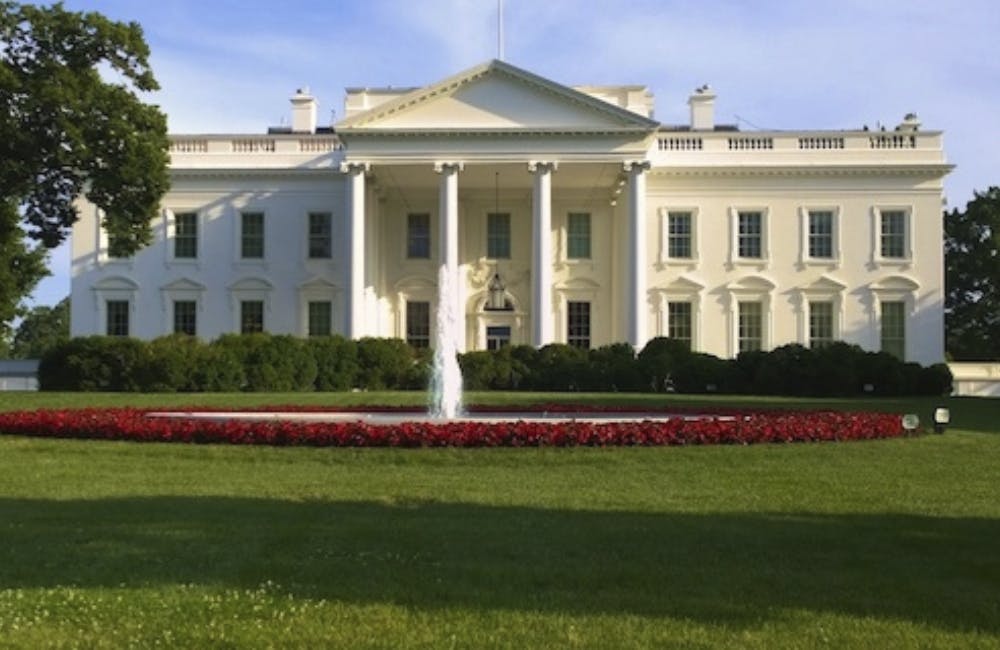Biden’s 2024 Budget Impacts IT Modernization Across Government
Cybersecurity, AI and health IT are major focuses in this year’s budget proposal.

Major health care and defense priorities highlight some of the major themes in President Joe Biden’s fiscal year 2024 budget that are poised to have big impacts across agencies.
Key takeaways include a renewed emphasis on fighting cybercrime via the departments of Homeland Security and Justice, developing and strengthening cyber and artificial intelligence (AI) activities across the Defense Department, and investing in IT modernization for public health data systems and cancer research.
For deep dives into the tech perspective on the president’s budget and why his budget priorities matter to government IT and cyber initiatives, click through the agency highlights.
- Defense Department
- Department of Homeland Security
- Department of Justice
- Department of Health and Human Services
- Department of Energy
- Department of Veterans Affairs
Defense Department
Biden’s budget request of $842 billion for DOD includes the largest funding request for research and development and space capabilities to date.
The Biden administration seeks $67.4 billion for cyber, IT and electronic warfare capabilities, $145 billion for research and development (R&D) activities and $33.3 billion for space capabilities for fiscal year 2024.
The 2024 budget request is a $26 billion increase compared to the 2023 enacted base level, as well as a $100 billion increase over fiscal year 2022.
“First and foremost, our budget is a procurement budget,” Deputy Secretary of Defense Kathleen Hicks told reporters Monday. “Our greatest measure of success and the one we use around here most often is to make sure that the PRC (People’s Republic of China) leadership wakes up every day, considers the risks of aggression and concludes, ‘Today is not the day.’”
The budget request seeks $13.5 billion for cyber activities, a 20.5% increase from the previous year. The activities include implementing a zero-trust framework department-wide, advancing next-generation encryption solutions, funding five additional Cyber Mission Force teams and increasing cybersecurity support to the Defense Industrial Base (DIB) through the Cybersecurity Maturity Model Certification (CMMC) program.
The budget request arrives days after DOD released its cybersecurity workforce strategy, which aims to address defense cyber workforce recruitment and retention efforts. It also comes on the heels of the White House’s National Cybersecurity Strategy released March 2, which sets cyber priorities for creating a secure digital ecosystem.
The White House also seeks $1.8 billion for DOD to adopt and deliver artificial intelligence (AI) capabilities and $1.4 billion to meet Joint All-Domain Command and Control (JADC2) demands.
JADC2 “is not the biggest number in the budget, but a very central organizing concept of how we’re trying to link information together,” Michael McCord, the Pentagon’s comptroller and chief financial officer, told reporters Monday.
The budget request includes $115 million for the newly established Office of Strategic Capital to bridge the “valley of death” and keep pace with innovation by attracting and scaling private capital for new tech capabilities.
“This is trying to connect us better with the venture capital world to get their ideas and their capabilities into our system,” McCord said. “It’s not connecting us to the Silicon Valley Bank, but it is connecting us to that world.”
DOD is highly interested in buying down technical debt. The president’s budget seeks $1.2 billion to promote cloud computing efforts and enhance the end-user experience.
“I don’t think we had more support at any particular meeting than on investing in that … Those are examples of some of the ways we’re trying to get better inside our house here,” McCord said.
Department of Homeland Security
President Joe Biden’s 2024 budget requests $60.4 billion for DHS, which includes $865 million for Citizenship and Immigration Services (USCIS), almost $25 billion for border security, $535 million for border security technology, and a $145 million spending boost for the Cybersecurity and Infrastructure Security Agency (CISA) for a total of more than $3.1 billion.
The 2024 budget is over a half a billion dollar decrease compared to 2023 enacted levels.
The budget allocates $25 billion for Customs and Border Protection (CBP) and Immigration and Customs Enforcement (ICE) — a $800 million increase from the 2023 enacted level — for improving border security between ports of entry, which comes as the immigration tribureau works to modernize services with emerging tech, such as AI and automation.
AI is one of the leading factors supporting DHS modernization by helping to close data gaps and improve data interoperability.
Modernizing immigration services will help accelerate immigration processes, improve data interoperability, decrease room for error, and help immigration officials stay prepared for changes and new trends.
Protecting national cyberspace is top of mind as the Biden administration requests $98 million for CISA to execute the Cyber Incident Reporting for Critical Infrastructure Act and $425 million toward internal cybersecurity and analytical improvements.
Biden’s push to make cybersecurity a priority is essential to provide a safe and protected digital ecosystem as cyber threats continue to proliferate.
Department of Justice
The White House has proposed $39.7 billion for the Justice Department’s fiscal year 2024, a 5.9% increase from the 2023 enacted level.
The proposed budget includes $17.8 billion for agency law enforcement, $51 million to the Federal Bureau of Investigation (FBI), $252 million toward police reform and a $63 million investment toward cyber threats.
A large sum of the funding will go to fight off cybercriminals, cyber terrorists and malicious foreign cyber actors, who often rely on cryptocurrency for ransomware payments. In March 2022, President Biden signed an executive order addressing national security concerns from digital assets and cryptocurrency.
DOJ recently created a new crypto enforcement team as digital assets increase alongside cybercrime. The Cryptocurrency Enforcement Team (NCET) monitors the illegal use of cryptocurrency, investigates those wrongdoings and prosecutes accordingly.
The White House also proposed an allocation of $63 million for the FBI to hire more agents, strengthen intelligence collection and enhance response capabilities to address cyber threats.
Department of Health and Human Services
The President’s 2024 budget request for HHS comes in at $144 billion, a $14.8 billion increase from 2023, which will go toward innovative ways to boost cancer research, modernize public health data systems and enhance data access to address health disparities as well as improve food safety.
The White House seeks $1 billion for Cancer Moonshot activities across the Centers for Disease Control and Prevention (CDC) and other agencies as well $7.8 billion for the National Cancer Institute (NCI) to accelerate technologies for improved cancer detection and research.
The budget request also asks for $2.5 billion for the Advanced Research Projects Agency for Health (ARPA-H) to pursue innovative health research and accelerate advancements for cancer treatment and prevention.
The budget outlines $10.5 billion in discretionary funding for the CDC to modernize public health data systems and better prepare them for future health emergencies. Also, for the first time in many years, the budget asks for $50 million for the Public Health Emergency Fund to ensure HHS has the capabilities to respond faster to emerging public health threats.
Another budget priority for HHS is improving maternal health and health equity. In the U.S., maternal mortality rates are disproportionately high for Black and American Indian and Alaska Native women. More funding is expected to go toward collecting and evaluating sociodemographic data to address health disparities and to give Black, American Indian and Alaska Native women better access to care.
Major IT efforts are also underway to improve food safety for all Americans. The budget requests more money for the Food and Drug Administration’s (FDA) smarter food safety initiative to enhance data access and analysis capabilities to improve the inspections process.
Department of Energy
The White House requests $52 billion in discretionary budget authority, a $6.2 billion or 13.6% increase from the 2023 enacted levels, to fund new technologies for the purpose of reducing greenhouse gas emissions, strengthening the energy sector’s cybersecurity and supporting energy communities.
The budget seeks $1.2 billion in DOE discretionary funding for technological advances that will help address climate change and greenhouse gas reductions while modernizing the U.S. industrial base for a more competitive future. If approved, this money would also support industrial decarbonization through innovation and technical assistance.
The budget also requests financial assistance for DOE to boost its IT infrastructure security. The White House asks for $245 million to increase the resilience of the energy sector by enhancing the security of clean energy technologies and the energy supply chain.
The budget allocates $905 million for the agency’s Office of Fossil Energy and Carbon Management toward new technologies and IT that can offer economic renewal opportunities in energy communities.
Finally, the budget asks for a historic investment of $11.3 billion at the National Science Foundation, an 18.6% increase over 2023 enacted levels, and $8.8 billion for DOE’s Office of Science for the purpose of advancing the CHIPS and Science Act to full authorization levels. These efforts aim to identify and expedite novel technologies for clean energy solutions, such as fusion technology, for which the budget requests a $1 billion investment. These investments would also focus on quantum information science and AI, which address scientific challenges and leverage data and analytics to strengthen and support U.S. biodefense plans.
Department of Veterans Affairs
The total fiscal year 2024 request for the Department of Veterans Affairs is $325.1 billion, a $16.6 billion increase above the fiscal year 2023 budget enacted level, to fund programs for veteran homelessness, suicide prevention, military exposures and modernizing infrastructure. Much of this request stems from work conducted over 2022 and into 2023 in data and technology solutions for veterans.
President Biden signed the PACT Act into law in August 2022, expanding health coverage for veterans facing military exposures. The budget requests $20.3 billion for the Cost of War Toxic Exposures Fund — $15.3 billion above 2023 — for health care, research and benefits associated with exposure to environmental hazards.
Since the legislation was signed, VA has made several investments in both technology and the workforce to deliver benefits to more than 3.5 million now eligible veterans. With the additional funding, the agency would be equipped to invest in its “people, process, technology approach,” which calls on expanding hiring strategies and tools like automation to improve the speed of benefits delivery.
The toxic exposures fund was used as a vehicle to fund the costs associated with toxic exposures beyond the fiscal 2021 base year, VA Chief Financial Officer Jon Rychalski told reporters March 9. In the initial tranche, Congress appropriated $500 million in 2023. VA provided a spending plan to appropriators, received approval and has been using those funds. The request includes another $5 billion.
“That toxic exposure fund is mandatory funding and the total amount that we have received so far is $5.5 billion. In fiscal year 2024, we’re requesting $20.3 billion,” Rychalski said. “The reason we’re requesting these funds in the toxic exposure fund is because Congress set it up for that purpose. We are trying to stay consistent with both congressional intent and also our ability to track and report on these costs. Keeping it all in one account from the beginning — the increased costs associated both with a PACT Act and with the growth of the costs associated toxic exposures — will make it easier for us to understand where the true costs are.”
The budget also proposes a historic investment of $4.1 billion for construction to begin restoring VA’s aging infrastructure and providing veterans with state-of-the-art health care facilities, as well as a $5 billion investment in medical care funding for non-recurring maintenance to improve medical facility infrastructure.
“This year, we are requesting some of our infrastructure funding — both major and minor — as mandatory funds,” Rychalski said. “That is something different that we have not done before.”
In the request, VA also would provide veterans with state-of-the-art health care facilities. The $5 billion discretionary investment in medical care funding will fund non-recurring maintenance to improve medical facility infrastructure.
The budget request provides $16.6 billion for mental health efforts, including suicide prevention, up from $15.0 billion in 2023. As a part of that, the budget includes $559 million for veteran suicide prevention outreach programs and an estimated $2.5 billion in suicide-specific medical treatment.
Over 2022, VA has made new strides to prevent veteran suicide with programs like Mission Daybreak, a grand challenge that awarded $20 million to innovators that will use funding to create programs and develop technology solutions for suicide prevention and other forms of mental health support.
“In sum, Mission Daybreak is a vehicle that brings clinical, community, policy and research backgrounds and contexts into innovation; then, redeploys innovation back into clinical, community, policy and research settings across the nation and around the world,” VA Executive Director of Suicide Prevention Matthew Miller told reporters last month.
Additionally, the new budget intends to invest $3.1 billion in providing homeless veterans — and veterans at-risk of homelessness — with permanent housing, access to health care and other supportive services.
During a Tuesday press briefing, Executive Director of the Veterans Health Administration Homeless Programs Office Monica Diaz told reporters that this year VA plans to place at least 38,000 veterans experiencing homelessness into permanent housing and ensure that at least 95% of the veterans housed in 2023 do not return to homelessness.
VA is using the Supportive Services for Veteran Families (SSVF) Homelessness Prevention Screening Tool and data dashboarding to improve tracking and measure success. The agency’s 38k dashboard provides insight into how many veterans each VA site housed in each program and how many veterans were in medical center catchment areas but not yet housed.
“With these historic investments, we at VA can continue to deliver more care and more benefits to more veterans than ever before in our nation’s history,” VA Secretary Denis McDonough said in a press release.
This is a carousel with manually rotating slides. Use Next and Previous buttons to navigate or jump to a slide with the slide dots
-

AWS Summit: A DOE National Lab Uses GenAI to Boost Efficiency
Lawrence Livermore National Lab launches a new generative AI tool to drive operational efficiency at the National Ignition Facility.
9m listen -

VHA’s AI Chief Led NIH’s New AI RFI
The agency's AI chief Gil Alterovitz helped develop a plan that hints at how NIH is charting the future of AI and biomedical research.
5m read -

DOE National Labs Launch New AI Tools for Operational Efficiency
The Energy Department's National Laboratories are using AI to increase operational efficiency and drive research efforts forward.
3m read -

White House AI Czar Outlines Industry's Role in Global AI Race
White House AI Czar David Sacks detailed the Trump administration's AI priorities and industry's role in growing the nation's AI economy.
3m read











